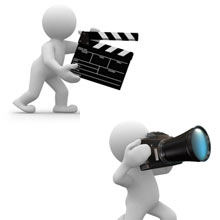 Video and the Web? It’s a match made in heaven.
Video and the Web? It’s a match made in heaven.
That’s why YouTube has been so successful and why every organization dreams to create a viral video – even if there is no real recipe to achieve virality.
So, what better way to engage your web visitors? Live video (often called live streaming)!
As you know, there is something exciting about experiencing live events.
But when you cannot be there, a live streaming event is the next best thing.
That’s the reason why I asked Seth Odell who works at UCLA and hosts the Higher Ed Live show to present a webinar about the topic in our upcoming series Professional Photos, Videos and Live Streaming 101 (Jan 18-20, 2011).
I also got to ask him a few questions about live streaming in higher education.
1) How long have you been doing live streaming?
I first began exploring the implementation of live streaming at UCLA in early 2008. At the time, I was looking for an affordable solution that could allow our communications department to live stream events in-house.
2) Why does it make sense to incorporate live streaming in higher ed content?
Live streaming offers colleges and universities the unique opportunity to engage their global audience in real-time. For the cost of labor alone, institutions can dramatically increase the reach of pre-existing campus events. In a time when budgets are tight, it simply doesn’t make sense to produce high-end events that only reach the small portion of our audience that can physically come to campus to participate. Live streaming is an affordable, social and scalable solution for delivering your message to members of your community around the globe.
3) In your opinion, what is the top reason for poor quality when it comes to live streaming
The number one reason for poor quality when it comes to live streaming is the inadequate amount of time many folks put into refining their live stream solution. Setting up a live stream broadcast itself is quite easy, but taking the quality of that stream to the next level takes time and testing. Depending on your camera and live stream platform, folks should be experimenting with Adobe Flash Media Encoder Live and desktop producers, as well as refining the basics of quality video production like camera placement, lighting and audio.
4) You will share many professional tips and tricks during your webinar, but can you give us 2 to 3 don’ts for professional live streams?
- Never stream via WiFi
When it comes to live streaming over WiFi, just because you can doesn’t mean you should. A fast and reliable internet connection is the backbone of any professional live stream. - Don’t forget to promote
It always amazes me how many institutions put in the time to learn how to live stream but don’t properly market and promote it. Getting folks to watch and engage a live streamed event takes a lot more than just a tweet or two. During the webinar I’ll break down the best approach to marketing your live stream, including one tip that landed UCLA over 50,000 viewers for a single event. - Don’t use a USB camera or webcam
This is another case of just because you can doesn’t mean you should. Utilizing a quality video camera is essential to a professional live stream experience. While there are a plethora of options to choose from, I’ll be sharing what the #1 recommended live stream camera is, according to an industry leading live stream platform.




Great advice… particularly about streaming over WiFi. It just doesn’t work. If there’s anyone who knows how to stream, it should be Seth Odell. Should be a great webinar.
Thanks for this post, Karine. “Don’t forget to promote” = error that happens far too often… and not just with live streaming!
I need to livestream music performances from our local Farmers Market, which is located in a parking lot next to our Fine Arts Theatre. Right now, wifi to the theater’s hotspot is the only internet connection nearby. My first tests have been disappointing: Procaster streams just stopped being received by the livestream server with no error message. Since I’m a network engineer, I would be happy to troubleshoot the underlying issues with wifi streaming in order to reconfigure whatever equipment is necessary to deliver the amount of QOS necessary for successful streams. Is there anyone out there who has done some preliminary research that would help me to get started on this? (I’m sure others in the world are encountering the same problem at live events: no hardwired connection available, only wifi. Feel free to email me at alan.mcrae@charter.net)
Hi Alan,
In order to stream without lag or dropped connection, you really need 1.5 MB upload speed or higher. Do you know what the upload speed is? You can check at http://speedtest.net. If it’s less than 1.5, unfortunately there isn’t a lot you can do to guarantee no issue.
You can actually run ethernet roughly 250 feet before the signal begins to have problems, so perhaps you could run a cable out a window and tape it down? A bit crazy, but that’s what I’ve done for outdoor shoots before.
Your other option is to pick up a wireless MiFi card, which when tethered, can have a steadier signal then a WiFi that is far away.
Hope this helps!
Seth